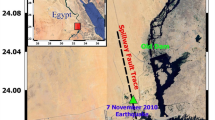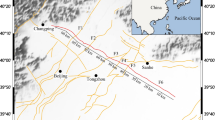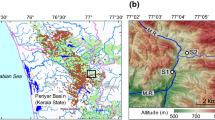Abstract
Coastal erosion is a global problem, affecting many countries around the world. On cliffed coastlines, erosion can be intermittent and sudden, posing an additional hazard to coastal communities. To mitigate such problems, it is necessary to understand the processes leading to cliff erosion. Here, we focus on the physical properties of the subsurface structure that might contribute to cliff instability. As a specific study site, we use the coastal region of the northern part of Bengkulu Province, which is well known as being prone to coastal abrasion/erosion. Seismic field surveys were conducted at five locations, using a 92 m seismic line with geophones spaced every 2 m. The measurements were processed using the Multichannel Analysis of Surface Wave (MASW) methodology with commercially available software. Our results suggest that the subsurfaces are divided into three layers where the top layers lie at thickness between 10 and 15 m with S-wave velocity (Vs) < 200 m/s (consistent with diluvial clay). The second layer has a thickness > 10 m with Vs between 600 and 800 m/s (consistent with loose sand), and overlays a bedrock layer for which Vs is much higher. We found between the first and second layers are a narrow ‘discontinuity region’ with Vs of 300–500 m/s (consistent with soft sand/silt). The configuration/composition/orientation of layers indicate stable permeable layers overlying saturated and impermeable layers at or below the sea level. The upper permeable layers are vulnerable to instability when subjected to external disturbances such as heavy precipitation, storm waves or earthquakes. The relatively mild wave climate and absence of notching around the water line leads us to conclude that variation in saturation levels is the primary driver of the observed cliff erosion.







Similar content being viewed by others
Availability of Data and Materials
Raw seismic data for this publication are available by personal request to asharml@unib.ac.id.
References
Amri K, Barchia MF, Aprizal Y (2017) Analysis of erosion hazardous level and sedimentation in Manna Watershed, Bengkulu Province Indonesia. In: Sriwijaya International Conference on Engineering, Science and Technology, Pulau Bangka, Nov. 9–10, 2016, MATEC Web of Conferences, 101, 04002, https://doi.org/10.1051/matecconf/201710104002
Anukwu G, Khalil A, Abdullah K (2018) Evaluating the effectiveness of the MASW technique in a geologically complex terrain. Paper presented at International Seminar on Mathematics and Physics in Sciences and Technology 2017. Batu Pahat, Malaysia, Oct. 28–29, 2017, Journal of Physics: Conference Series, 995, https://doi.org/10.1088/1742-6596/995/1/012059
Ashton AD, Murray AB (2006) High-angle wave instability and emergent shoreline 313 shapes: 1. Modeling of sand waves, flying spits, and capes. J Geophys Res Earth Surf 111(F4):314. https://doi.org/10.1029/2005JF000422
Aziman M, Hazreek Z, Azhar A, Haimi D (2016) Compressive and shear wave velocity profiles using seismic refraction technique. Paper presented at the 4th International Conference on Science & Engineering in Mathematics, Chemistry and Physics 2016. Bali, Indonesia, Jan. 30–31, 2016, Journal of Physics: Conference Series, 710, https://doi.org/10.1088/1742-6596/710/1/012011
Case M, Ardiansyah F, Spector E (2007) Climate change in Indonesia implications for humans and nature. World Wide Fund for Nature (wwf News) 1: 1–13. wwf.panda.org
Chandran D, Anbazhagan P (2017) Subsurface profiling using integrated geophysical methods for 2D site response analysis in Bangalore city, India: a new approach. J Geophys Eng 14:1300–1314. https://doi.org/10.1088/1742-2140/aa7bc4
Dal Moro G (2014) Surface wave analysis for near surface applications, 1st edn. Elsevier, p 252 (ISBN: 9780128007709)
Daryono LR, Nakashima K, Kawasaki S, Suzuki K, Suyanto I, Rahmadi A (2020) Investigation of natural beachrock and physical-mechanical comparison with artificial beachrock induced by micp as a protective measure against beach erosion at Yogyakarta Indonesia. Geosciences 10(1):143
Dickson ME, Walkden MJA, Hall JW (2007) Systemic impacts of climate change on an eroding coastal region over the twenty-first century. Clim Change 84:141–166. https://doi.org/10.1007/s10584-006-9200-9
Dikmen U, Arısoy MO, Akkaya A (2010) Offset and linear spread geometry in the MASW method. J Geophys Eng 7:211–222. https://doi.org/10.1088/1742-2132/7/2/S07
Eccleston P, Spyrou A (2019) Analysis of geophysical datasets for coastal vulnerability and asset management. ASEG Ext Abstr 1:1–3
Foti S, Lai CG, Rix GJ, Strobbia C (2015) Surface wave methods for near-surface site characterization, 1st edn. CRC Press, Boca Raton, p 487 (ISBN 9781138077737)
Hemer MA, Fan Y, Mori N, Semedo A, Wang XL (2013) Projected change in wave climate from a multimodel ensemble. Nat Clim Change 3:471–476
Hussain Y, Cardenas-Soto M, Martino S, Moreira C, Borges W, Hamza O, Prado R, Uagoda R, Rodríguez-Rebolledo J, Silva RC, Martinez-Carvajal H (2019) Multiple geophysical techniques for investigation and monitoring of Sobradinho Landslide Brazil. Sustainability 11:6672. https://doi.org/10.3390/su11236672
IPCC (2007) Climate change 2007: the physical science basis. In: Solomon S et al. (ed) Contribution of Working Group I to the Fourth Assessment Report of the Intergovernmental Panel on Climate Change. Cambridge University Press, Cambridge, New York
Keceli A (2012) Soil parameters which can be determined with seismic velocities. Jeofizik 16:17–29
Keskinsezer A, Dağ E (2019) Investigating of soil features and landslide risk in Western-Atakent (İstanbul) using resistivity MASW, Microtremor and Boreholes Methods. Open Geosci 11(1):1112–1128
Lubis AM, Isezaki N, Sato T (2011) Two-dimensional coseismic deformation field of the Sumatra–Andaman earthquake 2004 Mw 9.2 derived from synthetic aperture radar observation. Remote Sens Lett 2(2):107–116
Lubis AM, Hashima A, Sato T (2013) Analysis of afterslip distribution following the 2007 September 12 southern Sumatra earthquake using poroelastic and viscoelastic media. Geophys J Int 192(1):18–37
Miller EB (2016) Seismic surface wave investigation of the Lake Erie Bluffs. J Geogr Earth Sci 4(2):11–30
Mimura N (2013) Sea-level rise caused by climate change and its implications for society. Proc Japan Acad Ser B Phys Biol Sci 89(7):281–301. https://doi.org/10.2183/pjab.89.281
Nicholls RJ, Leatherman SP (1995) The potential impacts of accelerated sea-level rise on developing countries. J Coast Res SI14:323
Owoc B, Marciniak A, Dzierżek J, Kowalczyk S, Majdański M (2019) Seismic imaging of the mesozoic bedrock relief and geological structure under quaternary sediment cover: the Bolmin Syncline (SW Holy Cross Mountains, Poland). Geosciences 9:447. https://doi.org/10.3390/geosciences9100447
Park CB, Miller RD, Xia J (1997) Summary report on surface-wave project at Kansas Geological Survey (KGS). Kansas Geological Survey, Lawrence, p 10
Park CB, Miller RD, Xia J (1999) Multichannel analysis of surface waves. Geophysics 64:800–808
Paski JAI, Permana DS, Alfuadi N, Handoyo MF, Nurrahmat MH, Makmur EES (2021) A multiscale analysis of the extreme rainfall triggering flood and landslide events over Bengkulu on 27th April 2019, The 9th National Physics Seminar 2020, AIP Conference Proceedings 2320, 040019-1-040019-8; https://doi.org/10.1063/5.0037508
Rehman F, El-Hady SM, Atef AH, Harbi HM (2016) Multichannel analysis of surface waves (MASW) for seismic site characterization using 2D genetic algorithm at Bahrah area, Wadi Fatima Saudi Arabia. Arab J Geosci 9:519. https://doi.org/10.1007/s12517-016-2544-1
Reynolds JM (2011) An introduction to applied and environmental geophysics. Wiley, West Sussex, p 710
Samdara R (2014) Laju perubahan muka air laut di wilayah perairan pantai Bengkulu dengan menggunakan satellite Altimetry (Indonesian). J Flux 11:197–203
Schwab FA, Knopoff L (1972) Fast surface wave and free mode computations. Methods Comput Phys Adv Res Appl 11:87–180. https://doi.org/10.1016/B978-0-12-460811-5.50008-8
Supriyono S, Utaya S (2019) Study of quality changes and determination of water pollution index at river watershed Bengkulu Sumatra. J Disaster Geogr Geogr Educ 3(2):20–33. https://doi.org/10.24036/sjdgge.v2i1.136
Supriyono S, Utaya S, Taryana D, Handoyo B (2021) Spatial-temporal trend analysis of rainfall erosivity and erosivity density of tropical area in air Bengkulu Watershed Indonesia. Quaestiones Geographicae 40(3):125–142. https://doi.org/10.2478/quageo-2021-0028
Toimil A, Camus P, Losada IJ, Le Cozannet G, Nicholls RJ, Idier D, Maspataud A (2020) Climate change-driven coastal erosion modelling in temperate sandy beaches: methods and uncertainty treatment. Earth Sci Rev 202:103110. https://doi.org/10.1016/j.earscirev.2020.103110
Türker U, Kabdaşlı MS (2006) The effects of sediment characteristics and wave height on shape-parameter for representing equilibrium beach profiles. Ocean Eng 33(2):281–291. https://doi.org/10.1016/j.oceaneng.2004.12.016
Wang J, Church JA, Zhang X, Chen X (2021) Reconciling global mean and regional sea level change in projections and observations. Nat Commun 12(990):1–12. https://doi.org/10.1038/s41467-021-21265-6
Warrick JA, Stevens AW, Miller IM, Harrison SR, Ritchie AC, Gelfenbaum G (2019) World’s largest dam removal reverses coastal erosion. Sci Rep 9:13968. https://doi.org/10.1038/s41598-019-50387-7
Xia J, Miller RD, Park CB (1999) Estimation of near-surface shear-wave velocity by inversion of Rayleigh waves. Geophysics 64:691–700
Acknowledgements
We would like to express our sincere gratitude to Research Center for Oceanography (P2O) Indonesian Institutes of Sciences (LIPI) for supporting this research. We also would like to thank students and technical staff from Physics Department, Bengkulu University for assisting with seismic data acquisitions during the field works. In particular, R Hanafi, who undertook UAV surveys of beaches in the study site. Tide gauge data at Sebat station and Pulau Baai station were obtained from http://tides.big.go.id/ provided by Geospatial Information Agency of Indonesia.
Funding
This study was funded by Demand Driven Research Grant (DDRG) through the Coral Reef Rehabilitation and Management Program-Coral Triangle Initiative (COREMAP-CTI) program (Grant Number B-1207/IPK.02/KS/III/2018).
Author information
Authors and Affiliations
Corresponding author
Ethics declarations
Conflict of Interest
Authors declare that they do not have conflict interest and they also do not have any competing financial interests.
Rights and permissions
About this article
Cite this article
Lubis, A.M., Samdara, R., Angraini, L. et al. Imaging Subsurface Structures at Fast Eroding Coastal Areas in Northern Bengkulu Using 2D Seismic MASW Method. Earth Syst Environ 6, 531–540 (2022). https://doi.org/10.1007/s41748-022-00301-5
Received:
Revised:
Accepted:
Published:
Issue Date:
DOI: https://doi.org/10.1007/s41748-022-00301-5




